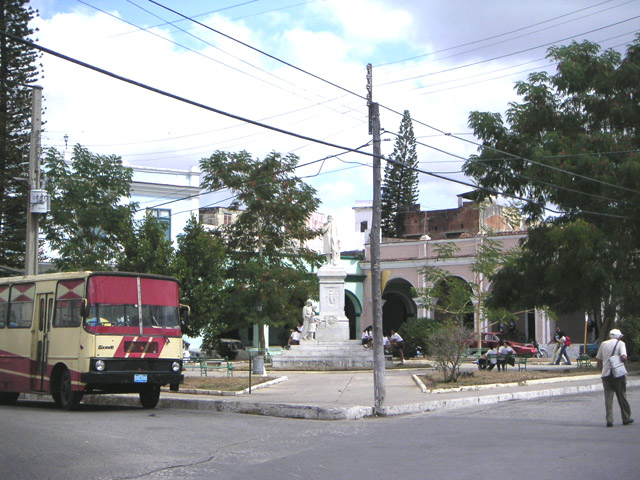(IN HOLGUIN PROVINCE) | Places |
HOLGUIN PROVINCE. INFORMATION
It is the fourth biggest province in the country and has more neighbour provinces because is surrounded by four provinces (Las Tunas, Gramma, Santiago de Cuba and Guantanamo). In the north the Atlantic Ocean bathes its coasts.
Its mountain region has a very important nickel and cobalt bed.
There, a big quantity of its rivers rise with a big flow.
Sierra Cristal, the highest point of the province has 1
231 meters high, but its best interesant orography is Silla de Gibara, a ridge that has the form of a big saddle and is located in mountainous country of Maniabón, in north of Holguin.
In Holguin there is the highest and deepest bay of Cuba, called Nipe Bay. Other important bays are Levisa and
Gibara.
Although Holguin was traditionally an agricultural region, nowadays
it´s one of the first industrial areas of Cuba. Called Tierra del Níquel (Land of Nickel), its production represents more than 15% of the incomes by exportation concept. You can find nickel mines and
procedural plants of this mineral in Moa and Nicaro and were built by north americans before 1959. Later was built a new procedural plant in Punta Gorda, near by Moa.
Some years ago the sugar cane production was important, but in this moment it´s smaller because of the reduction of sugar factories. It has extensive areas of citrics and tobacco.
The fish industry has an important place. The touristy industry has been quite developed in the last years and will become very important.
Holguin Province has the following Municipalities:
Holguín, Moa, Gibara, Frank País, Cacocun, Baguanes, Cueto, Antilla, Calixto García, Rafael Freyres, Urbano Noris, Banes, Mayarí and Sagua de Tánamo.
Ciudad
de Holguin (Holguin City)
Since 1976 Holguin City is capital of the province. .
 This city was
founded in 1525 by captain García Holguín when he received a part of land in this zone and built the first houses. More than two centuries later, the 18th January, 1752, was declared municipality and began
the development as small city until this became an important city.
This city was
founded in 1525 by captain García Holguín when he received a part of land in this zone and built the first houses. More than two centuries later, the 18th January, 1752, was declared municipality and began
the development as small city until this became an important city.
Loma de la Cruz (Cross Ridge)
Is the place more famous in this city. It´s located in the western site of the city and before was called Cerro del Bramadero. In 1790 people put there a cross to offer cult
to the 3rd of May (Cross Day). This festivity
is simultaneously saint and desecrated. This activity begin with a pilgrimage
until this place and celebrate a mass. After that, there is a party, a happy country fest
(romería) with music and dances. The access stair, with 450 steps,
was inaugurated on 3rd May 1950. From the circular square located in the top of the hillock, is possible to see a nice view of all the city. For this reason this place was turned into a view point (the Spaniards built in this place a watch tower).
Guardalavaca beach. This place is a very important touristy area. It´s located in the northern coast of Holguin.
Mirador de Mayabe (Panoramic sight place of Mayabe)
Located in the high part of a hill outside of the city. It´s a natural balcony, where is possible to see all Mayabe Valley,
which surrounds Holguin city. There is a touristy centre.
In Mayabe used to live a very funny and popular character : Pancho donkey,
it drank beer and ate crackling of pig.
La Villa Blanca de Gibara (The White Village of Gibara)
It is a little mariner city to 30 km of Holguín, with narrow
and elevated streets, old fishermen houses and tens of boats floating in the bay. Its name is Gibara, but people know it as Villa Blanca.
Gibara port was in XIX century the principal maritim access
in the northwestern coast of the country. Nowadays it is a port mainly for
small ships, which find important fishing areas
in the adjacent seas.
In Villa Blanca de Gibara there is a typical museum from the XIX Century (Museo de ambiente Cubano del Siglo XIX). This is a mansion of neoclassical architecture built in 1872, decorated as a family house, with a living room and bedrooms, dinning room, kitchen and halls, each of them with antique furniture and objets from the epoch.
Puerto de Bariay (Bariay Port)
Through this port, close to Gibara City, landed in Cuba the High Admiral Cristopher Columbus (Cristobal Colon), the 28th October 1492, to begin with the discovering of America a new era. This fact gave to this place a historical importance.
Banes
Important city in the northern coast and has a bay with the same name